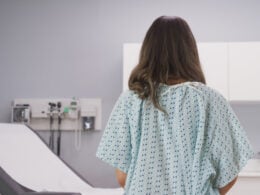Endometriosis affects approximately 89 million women worldwide. It affects all ages and races, and is one of the leading causes of female infertility.
Pain from endometriosis causes girls and women to miss school and work—or perhaps worse—to endure both while in excruciating pain. For as common as it is, very little is known about this disorder. Here is what we do know:
What is endometriosis?
Endometriosis is a disorder where tissue similar to that which lines the uterus (called the endometrium) grows outside of the uterus. This tissue typically grows on other organs in the pelvic area, such as the ovaries and fallopian tubes. Just like the endometrium, this tissue also breaks down and bleeds during menstruation, but because it has no way to exit the body, it stays in the pelvic area. The trapped blood and tissue then causes a “foreign body” reaction. This reaction causes inflammation and swelling of the tissues to which the endometrial implants are attached, which eventually forms scar tissues, adhesions, and bands of tissue that may grow between pelvic organs and cause them to stick together.
Sometimes these endometrial implants occur within the muscle wall of the uterus (adenomyosis), which contributes to the heavy bleeding and pain associated with the disease. This cannot be diagnosed with laparoscopy, but may be seen on ultrasound or MRI of the uterus.
What are the symptoms of endometriosis?
The most common symptom of endometriosis is pain. Endometriosis is associated with especially severe pain during periods that is much worse than typical menstrual cramps. Pain with sex is also a common symptom. Oddly enough, the level of pain someone experiences with endometriosis is not a good gauge of how advanced the disease is. Some women may have very few lesions and/or small amounts of endometriosis, and an inordinate amount of pain; others may have very extensive scarring, yet little to no pain. Laparoscopic surgery is necessary to make a formal diagnosis of endometriosis.
- The Difficulties of Diagnosing and Categorizing the Stages of Endometriosis
- Spotting between your periods could be a sign of endometriosis
- 4 Reasons It’s Worth It to Get a Fertility Awareness Instructor
What causes endometriosis?
Endometriosis is not well understood, and for a variety of reasons (including lack of patient and provider awareness, dismissal of women’s pain, and misdiagnosis) takes an average of 8 years to diagnose from the onset of symptoms. The exact cause of endometriosis is also unknown, although multiple theories abound. Some research suggests a connection between endometriosis and autoimmune diseases but further investigation is needed to confirm the nature of the relationship. Estrogen dominance may also contribute to endometriosis and other reproductive disorders. Other theories involve retrograde menstruation with the onset of menses, and lymphatic and vascular transport.
Perhaps one of the reasons we know so little about endometriosis is because young women are often placed on symptom-masking hormonal birth control as soon as they present with menstrual difficulty, only to come off of it later in life (perhaps when they wish to get pregnant), and find that the disorder never really went away while they were on the pill. In fact, there are no published articles in the medical literature showing that hormonal contraceptives “treat” endometriosis; they are simply used to mask the symptoms.
Another source of delay in diagnosis, especially in teenagers, is that physicians may be reluctant to subject these young women to laparoscopic surgery under general anesthesia. The American College of Obstetricians and Gynecologists (ACOG) recommends diagnostic laparoscopy only if a teen girl’s period pain or other chronic pelvic pain persists after taking non-steroidal anti-inflammatory drugs (NSAIDs) like Ibuprofen or Motrin plus hormonal birth control like the Pill.
- Scientific American Addresses the Problem of Birth Control Suppressing Periods
- How Observing Birth Control Side Effects Drove One OBGYN to Offer Fertility Awareness in Her Practice
Can I use a fertility awareness method with endometriosis?
Yes! In fact, learning to chart your cycle with the help of a trained instructor and/or a medical provider familiar with your FABM can help you detect signs of endometriosis.
Is endometriosis treatable?
Hormonal contraception is often prescribed to manage the symptoms of endometriosis, but it does not cure the disorder. In fact, while it may keep the patient from feeling as much pain, it may also allow the disease to progress unchecked. If a patient is not on the pill, surgical intervention may be more likely to take place at an earlier stage of the disease.
Restorative reproductive medical providers have pioneered various surgical techniques for the treatment of endometriosis in an attempt to manage the disease itself (rather than just its symptoms). Treatment may involve laparoscopic surgery to excise the lesions caused by endometriosis, as well as diet, exercise, and nutritional supplementation. Note that surgical excision is generally considered superior to surgical ablation, and that finding a surgeon trained in endometrial excision is essential to eliminating the disease.
Another valid treatment that leads to remission of endometriosis and its symptoms is the use of a GnRh agonist (such as Lupron) which basically makes the patient “pseudo-menopausal,” shutting down all hormone production, and thus allowing the endometrial implants to regress.
- Considering endometriosis surgery? Here’s how to find a good endo surgeon
- How I got help with endometriosis without the Pill
- FDA Citizen’s Petition on Birth Control: Shocking Stories of How Women Are Getting Hurt
Is there a cure for endometriosis?
Although there is technically no cure for endometriosis, thorough surgical excision of endometrial lesions can get a patient as close to a cure as possible. Lifestyle modifications, including an anti-inflammatory diet and exercise to restore proper hormone balance, may help naturally decrease endometriosis pain. For a long time, it was believed that pregnancy could “cure” endometriosis, which we now know is a myth (although pregnancy may temporarily reduce endometriosis symptoms). Actress Lena Dunham made headlines with her decision to have a hysterectomy to cure her endometriosis, but the Endometriosis Association warns that “combined with thorough excision, [a hysterectomy] may reduce or eliminate symptoms; not a sure cure.”
- Coming off the Pill with Good Nutrition
- Supplements for PMS Symptoms that Really Work
- How to Solve Period Issues without the Pill
- Tips to Improve Hormone Health Right Now
- Achieving Thyroid and Hormone Health: An Interview with Laurie Christine King
Can endometriosis cause infertility?
Endometriosis affects about 6-10% of women of reproductive age, and 30%-50% of women struggling with endometriosis are infertile. This makes endometriosis one of the leading causes of infertility. However, that does not mean that every woman with endometriosis will be unable to conceive. If you are having trouble trying to conceive, it may be worth investigating whether or not you have endometriosis with your physician. Practitioners of restorative reproductive medicine, including NaProTechnology physicians, are trained in alternative treatments which may offer better resolution than a typical approach. If successful, these approaches may also cure a woman’s infertility.
- Treating disorders
- Find a fertility awareness doctor
- 3 Reproductive Health Disorders I’ve Seen Solved by NaProTechnology
- How fertility awareness helps “infertile” women get pregnant
This page was last updated on July 26, 2023, with information on the American College of Obstetricians and Gynecologists’ position on when diagnostic laparoscopy is appropriate for teen girls.











